Table of Contents
QUICK SUMMARY:
Effective client goal-setting is extremely valuable for managing marketing campaigns. This three-step approach helps to define, establish, and maintain realistic goals that align with a client's vision while supporting sustainable growth. Tracking progress through marketing analytics ensures campaigns stay on course. This guide shares how to build trust, align strategies, and measure success for data-driven outcomes.
Marketing goal setting is just as important for your clients as generating leads, creating solid content, and boosting brand engagement. After all, if you don’t know where you’re going, it’s near impossible to get there.
Creating and managing clear, measurable goals for your clients not only encourages growth, it allows your marketing agency to focus its efforts on what matters most and ensures that success can be easily tracked.
We've always known that success comes from a combination of strong relationships, exceptional services, and data-driven decision making. These are the key factors that have propelled us to where we are today, and we continue to rely on them as we look towards the future.
Adam Binder, Founder + CEO, Creative Click Media
Still, setting realistic marketing goals is often easier said than done. Some clients may be too ambitious with their goal setting, while others could be wary of any change necessary to achieve these milestones.
Today, we explore how to successfully guide your clients through defining, setting, and managing key marketing goals in 3 steps.
Step 1: Get on the Same Page About Your Clients’ Objectives
Before any marketing goals are set, your agency needs to align with your clients’ ambitions and priorities. Agencies that are disconnected from their clients run the risk of setting short-sighted goals that don’t take long-term growth into account.
A client may say they want their domain authority strengthened, but what they really want is higher rankings for the right keywords that bring them new customers.
Daniel Noakes, Founder, UClimb
For another example, if you’re working with a startup looking to increase brand loyalty in the long-term, an aggressive ad campaign to boost website traffic may not be the best focus point. Instead, it would make sense to invest in solid content marketing for the website that connects with the customer’s audience first.
Aligning Through Trust-Building
In order to properly align with your clients’ expectations, you first need to build trust through transparent communication.
Like all of us, clients want to be heard and understood. Agencies that push their own interests will struggle to address customer pain points, leading to a lack of client retention efforts and a subpar customer experience.
In order to properly build trust, show your clients that you’re listening. Some effective ways of getting feedback include:
Customer surveys. These can be used to determine customer satisfaction as well as which areas the client cares about most.
One-on-one check-ups. This is an effective way of connecting with each company’s key decision makers to ensure you’re going in the right direction.
Team-wide feedback sessions. This is a great way to encourage collaboration, and discussion about specific campaign goals.
The onboarding process always begins with a comprehensive client consultation to thoroughly understand their business objectives and priorities. We immerse ourselves in their vision and challenges.
Rubin Roel, President, Investigator Marketing
Understanding Your Clients’ Priorities
During this phase of the marketing goal-setting process, it’s important to learn as much as possible about your client’s business. Some effective questions to ask include:
What’s your selling point? Why would a customer choose your business? This may be different for eCommerce goal setting versus B2B services.
What type of customer experience do you aim to provide?
What sets you apart from your competition?
What are your customer’s pain points and how does your product/service solve them?
Where do you see your business in the next five years? What type of growth is realistic for your company?
One of the most impactful leadership mistakes I made in the early days of my agency was neglecting to set clear expectations from the outset, both within my team and with our clients. The assumption that everyone was on the same page, without expressly articulating our goals, timelines, and deliverables, created a ripple effect of challenges.
Adam Stewart, Founder, Digital Bond
Step 2: Leverage a Goal Setting Framework
Once you understand your clients’ growth perspective, you’ll be able to start creating solid marketing goals that support their long-term success.
While marketing agencies often turn to SMART marketing goals when looking for a goal-setting framework (a traditional option that focuses on Specific, Measurable, Attainable, Relevant, and Time-bound categories), the MASTER framework is often a better choice as companies evolve and goals become more complex.
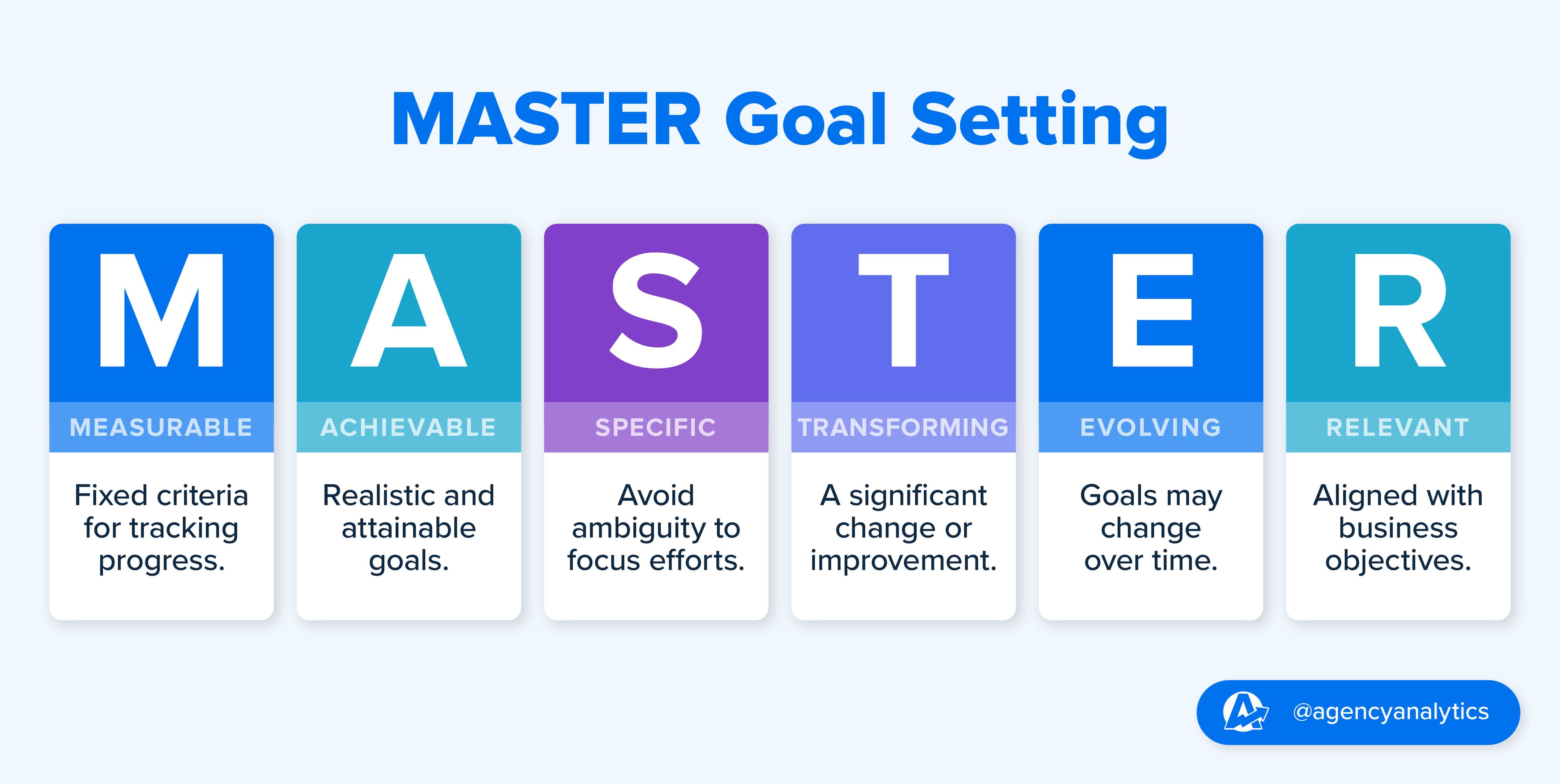
Understanding the MASTER Framework
The MASTER framework stands for:
Measurable:
In this framework, it’s important to identify marketing goals that can be effectively measured through data and analytics.
To start, you’ll help your client break down exactly what they want to achieve. Together, you’ll pinpoint which key performance indicators (KPIs) are the best to track.
For example, let’s say you’re working with a startup looking to increase brand awareness for a new product that just launched.
A measurable marketing goal would be: increase brand awareness by 10% in the next 4 months. A key KPI to track could be social media engagement.
All marketing goals should be tied back to these KPIs. This way, your client will be able to track each benchmark as you work toward achieving their goal.
Tools like AgencyAnalytics' custom marketing dashboards ensure your clients are able to easily track analytics specific to each goal.
Achievable:
Using this framework, you’ll be able to choose goals that are the perfect balance of realistic and ambitious. Marketing goals should be achievable within a specified period of time.
This step will ensure your client isn’t setting overly ambitious goals you won’t be able to meet. In our example above, an overly ambitious goal may be increasing brand awareness by 50% in two months or an unrealistic SEO expectation could be to get Top 10 rankings for 20 high-volume keywords within two weeks.
At this point, it’s your job to guide your client towards a more attainable benchmark.
Specific:
At this stage, it’s time to pinpoint exactly what your client wants to attain.
This helps narrow down the marketing goals and ensure everyone involved understands what’s needed to meet the set targets.
As the name suggests, be as specific and clear as possible.
Again, using our example, an ambiguous goal you’d want to avoid would be “increase website traffic to the new product’s landing page,” while a specific goal would be: “increase website traffic to the new product’s landing page through social media by 10% in 3 months”.
In the second marketing goal, we know exactly what needs to be achieved (increase web traffic), how it’ll be achieved (through social media campaigns), by how much (10%), and when (in 3 months).
When we begin working with a client we always make sure we understand what their goals are as a business first. This can sometimes be tough, especially if the goal is to "increase revenue" or "get new clients.” It's important to get really clear and specific so that everyone is on the same page about what success looks like (no assumptions).
Kerrie Luginbill, Chief Strategy Officer and Partner, OTM
Transforming:
This is where we throw gas on the metaphorical flames.
The transforming step is when you add an emotional component to the goal to create excitement and encourage business growth. Find an element that will inspire and motivate your clients to invest in this goal.
Going back to our example, let’s consider the pain points of selling a product with low brand awareness.
There’s nothing more frustrating than having a great product to sell, but no one to sell it to. Achieving the goal of increasing brand awareness by 10% would be transformative because it would immediately place your client’s products in the line of sight of consumers–and ideally lead to conversions.
Evolving:
As the market changes, your client’s goals will inevitably change with it. This stage allows for flexibility and adaptation.
The goal must be able to evolve when the client’s needs change. For example, if your client’s startup suddenly loses several team members, you may need to change the time frame of the goal.
If the original goal was, “increase web traffic to the new product’s landing page through social media by 10% in 3 months”, you might change it to 6 months to allow the company to hire new employees.
Our job is to be the most responsive to our clients and their goal from a marketing perspective. Being proactive rather the reactive is the difference successful and unsuccessful campaigns.
Pierre Ajram, SEO Director, AiiMS
Relevant:
Ensure all goals are relevant to your client’s values and growth philosophy. This is an important step that matches goal setting with each team’s direction.
No one wants to spend time and money on a goal that isn’t relevant to long-term growth.
In our example, the goal of brand awareness is relevant for the early stage of the business lifecycle that the startup client is currently experiencing. If the client was an established brand with an existing foothold in the market, brand awareness would not be a relevant goal.
Creating an Effective Review Process
Once marketing goals are set, it’s essential to review the goals at specific intervals.
This way, your marketing agency will know when you’ll need to pivot and adjust each goal to better align with your client’s needs.
In general, it’s a good idea to hold:
Weekly meetings with your client to track short-term measures and ensure you’re staying on track.
Monthly meetings where the marketing goals are analyzed in depth. At this point, you’ll be able to review if the goals are continuing to follow the MASTER framework. It’s also a good time to make minor changes to your marketing strategies if necessary.
Quarterly meetings, where you’ll hold comprehensive reviews to determine whether there were any changes in the market that would cause the goal to shift. This is also a good time to consider how client demands or agency direction may affect the goal.
Annual meetings. Think of this check point as both a look forward and look back. You’ll evaluate how successful your agency has been in meeting client goals and begin thinking of new MASTER goals for the year ahead.

Use AgencyAnalytics to track progress towards your client’s MASTER goals. Try it free today for 14 days!
The Top 10 Most Common Marketing Client Goals
While each client’s goals will be unique, the following are the most common marketing goal examples.
1. Raising Brand Awareness
As we looked at in our earlier example, this is one of the most popular goals for many companies. According to a Hubspot survey, brand awareness was cited as one of the top 3 marketing goals, with 20% of companies saying boosting brand awareness was their most important goal.
Tips for Success
Ensure your client has a clear, identifiable brand voice used across all marketing platforms.
No one wants to be sold products day and night. Instead, focus your marketing strategies on creating content that engages with your client’s customers and creates a narrative that captures their pain points.
Figure out where your client’s customers spend the most time and focus campaigns on that channel.
Share of voice correlates more directly with brand awareness and affinity. Brand strength drives higher average ticket and higher conversion rates. Branded searches also typically have higher click through rates.
Vi Wickam, President, Wizard of Ads Online
Measuring Brand Awareness
Brand awareness is often best measured quantitatively.
On social media, this includes brand mentions, reach (for example, on LinkedIn, reach can be measured by impressions per post), and follower count. For SEO, track organic search traffic, keyword rankings, organic conversions, competitor analysis, and SEO site health.
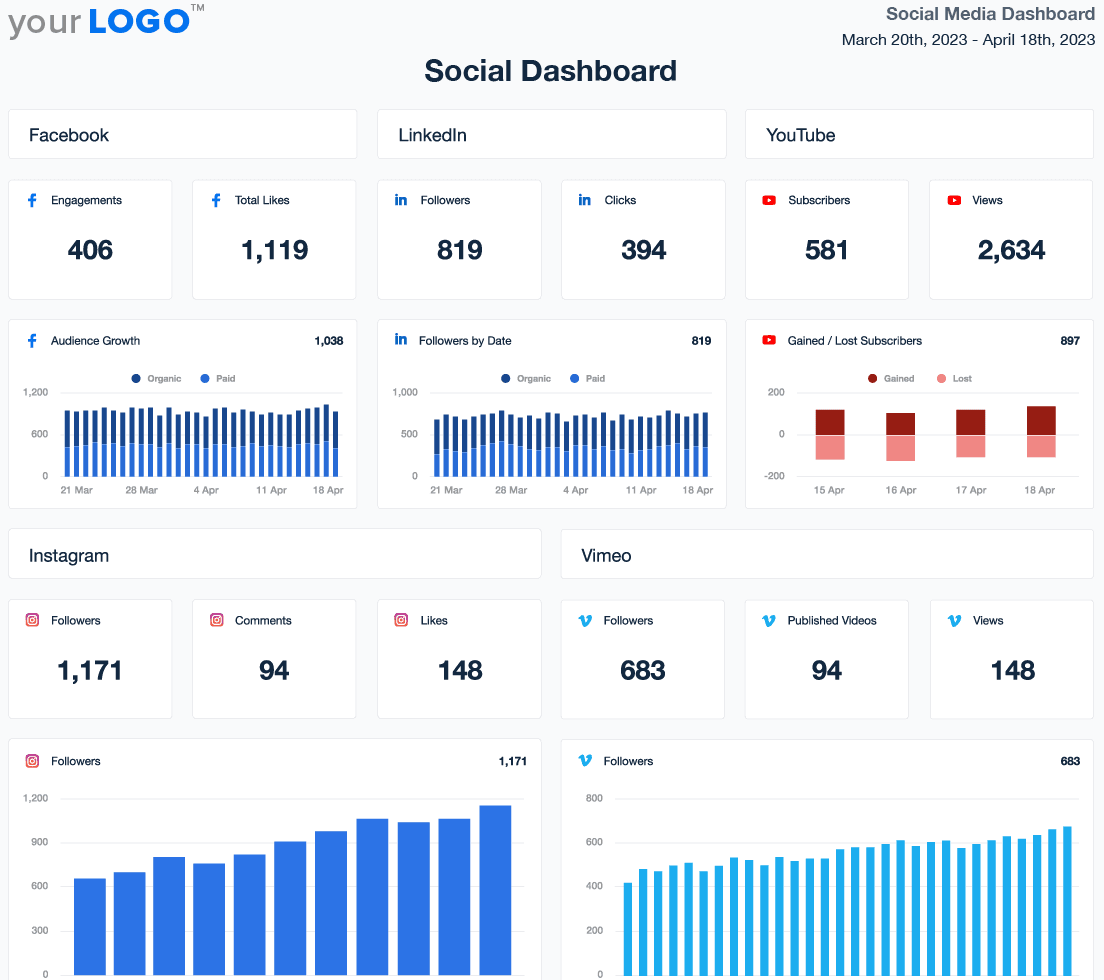
Easily track a client's social media presence with a customizable social media reporting dashboard.
2. Lead Generation
According to another Hubspot survey, 61% of marketers admitted that bringing in more leads and traffic was their biggest challenge in 2023.
Tips for Success
Ensure your client’s website is engaging and has a clear CTA that leads to a contact form.
Invest in lead generation strategies such as email marketing, social media campaigns, and content marketing.
Focus your digital marketing strategy on pay-per-click campaigns, such as Facebook or Google ads. This is a great way to attract potential customers.
PPC goals are created by determining what the client needs to grow and defining metrics within the ppc dashboard to match it. For example, we utilize close rate, website traffic, and tracked conversion actions to find the whole picture and link it to overall lead and revenue growth.
Rebecca Peña, Marketing Director, Investigator Marketing
Measuring Lead Generation
Some important KPIs to measure include click-through rates, conversion rates, and cost per lead.

Use the HubSpot data integration to create lead reports in minutes.
3. Customer Acquisition
Gaining new customers is another challenging goal for many clients, especially those who are still establishing themselves in their market and have just started working on their marketing strategy.
Tips for Success
Before choosing a plan to improve customer acquisition, it’s helpful to create ideal customer personas. This will ensure your agency knows who you’re targeting and what matters most to that audience.
Customer value matters. Have a clear value proposition before launching any campaign or attracting potential customers.
Focus on creating a solid online presence for your client. Leveraging social media is key here, as is increasing social media followers.
Measuring Customer Acquisition Success
Some KPIs to keep an eye on include churn rate, total new customers attained, product sign-ups, and customer acquisition cost.

The Shopify reporting integration helps agencies turn raw Ecommerce data into actionable client reports quickly and easily.
4. Increasing Traffic
Driving traffic to the correct channels is a major marketing priority for many clients.
While the traffic will vary depending on your client (a retail store will want to increase foot traffic while an eCommerce company will be looking at their website traffic), this is a crucial goal for many businesses.
Tips for Success
Website Traffic
Invest in blogs and other content writing strategies.
Focus your marketing strategy on paid ad campaigns and SEO efforts.
Make sure the messaging across all channels leads the target audience back to the website.
Foot Traffic
Introduce in-store promotions.
Like web traffic, paid ads are a great investment.
Measuring Foot Traffic
Foot traffic has its own unique KPIs, including:
Foot traffic count (telling you how many people entered in a specific time frame).
Conversion rate (in this case, you’re measuring how many people enter the store and purchase something).
Dwell time (how long people spend in a store).
Measuring Web Traffic
Keep an eye on the following KPIs:
Total sessions.
Number of conversions by traffic source.
How long, on average, people are spending on the website.
How many unique page views the site is getting.
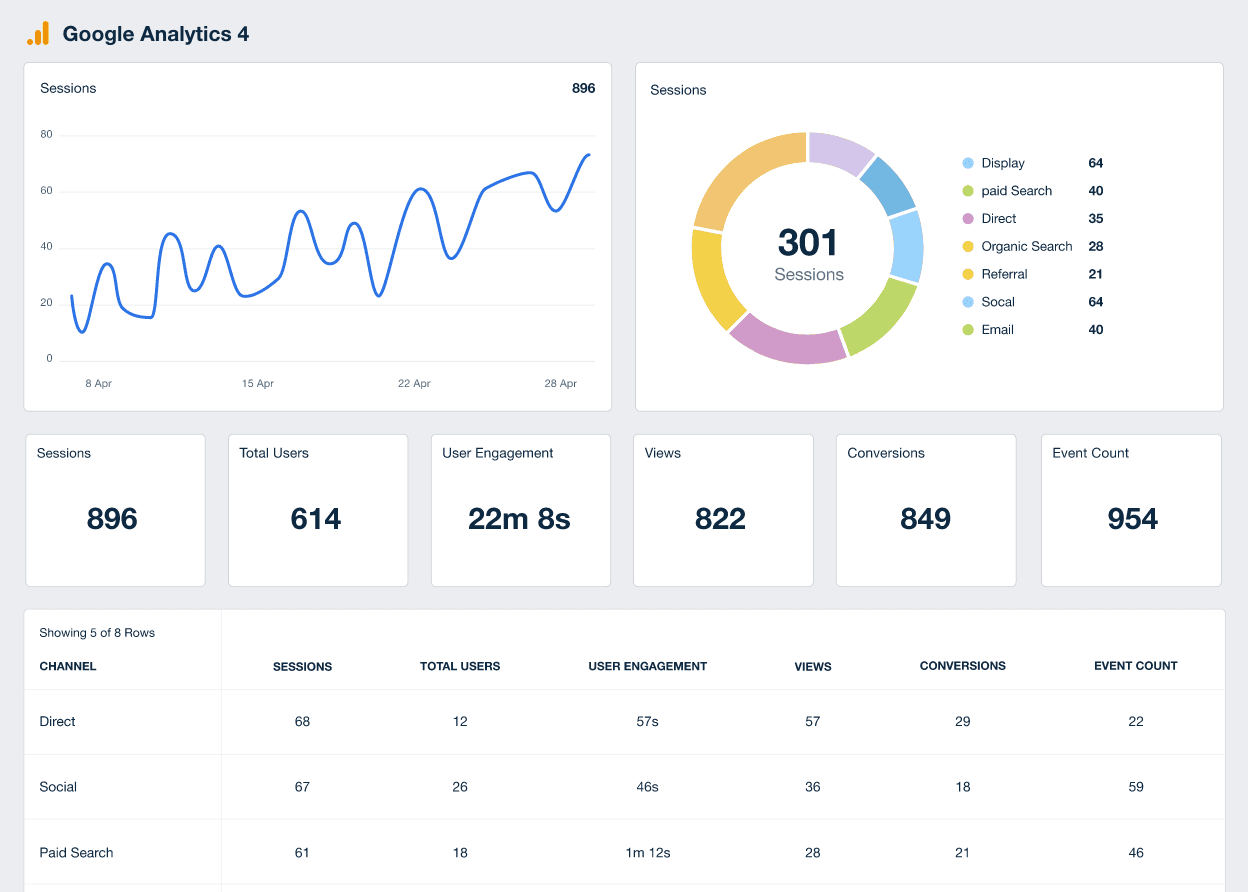
Turn complex Google Analytics 4 data into easy-to-understand web analytics dashboards.
5. Brand Engagement
This is another key goal, especially for clients working to scale their companies and establish a strong market presence. According to a Statista study, increasing brand engagement was the second most important goal for influencer marketing campaigns run in the U.S. in 2022.
Tips for Success
Before you implement a successful marketing strategy, make sure you have a clear understanding of what matters most to your client’s audience in order to properly boost brand engagement.
Share valuable content consistently and ensure all communication is personalized.
Don’t just join the conversation, start it. Powerful social posts and online marketing efforts are super valuable here.
Giveaways and contests are a great way to incentivize engagement.
Measuring Brand Engagement
Which KPIs you track will depend on the channels you’re focused on. For social media, you’ll be tracking shares, likes, comments, and reposts. For customer engagement, you could track net promoter scores (NPS), customer satisfaction rates, how long web sessions last on average, referral rates, and email KPIs include opens and clicks..
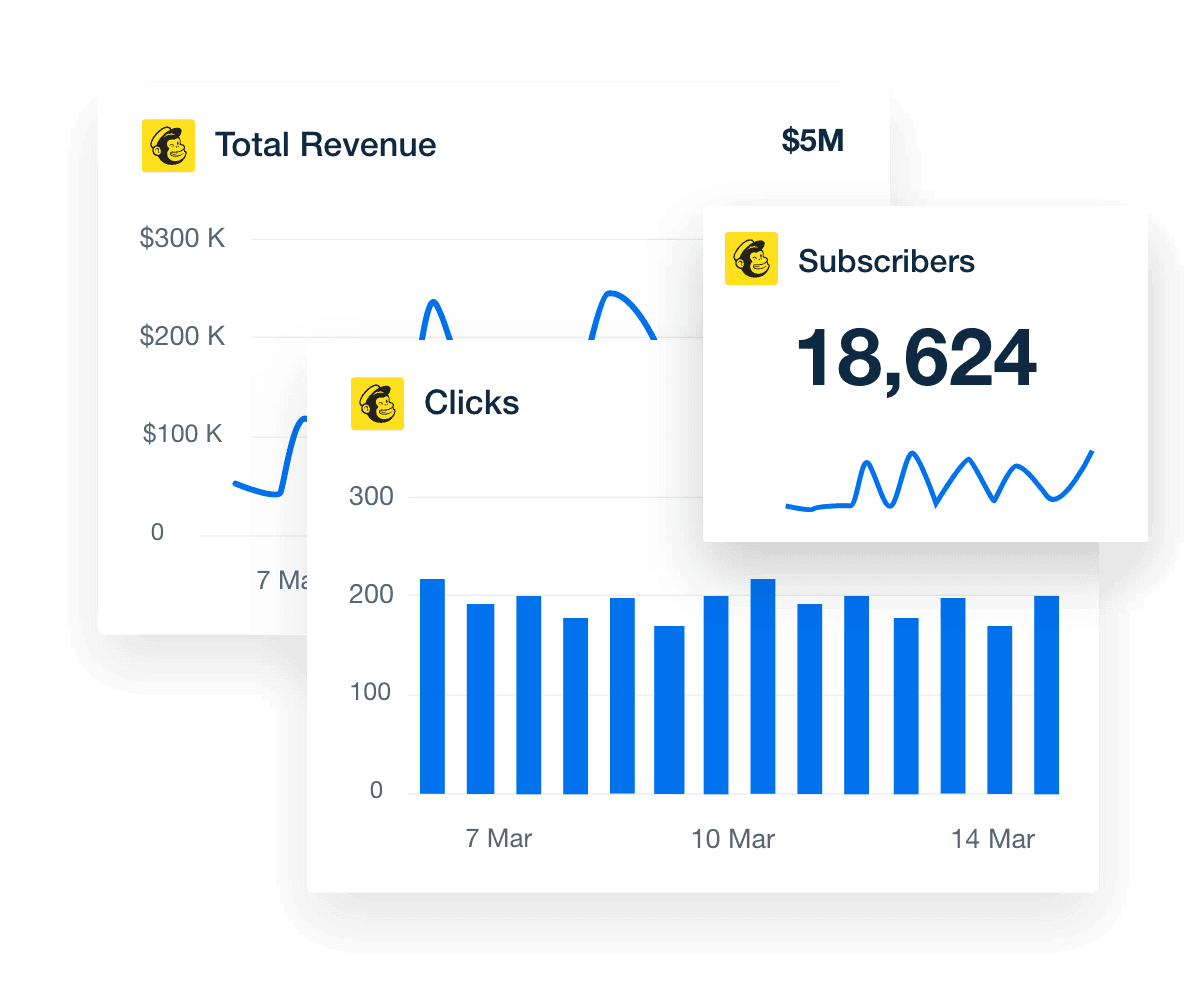
Create a Mailchimp dashboard to automatically create stunning client reports.
6. Industry Authority
Essentially this is thought leadership. By establishing your clients as an authority in their field, they’ll be more likely to be seen as a credible, solid company worth investing in.
Tips for Success
Invest your agency’s marketing efforts in long-form, educational content, such as whitepapers and articles.
Use partner networks to reach more of your client’s audience faster.
Use social media posts to increase your client’s authority on the topics that matter most to their audience, increasing their thought leadership status.
Measuring Industry Authority
While this is often difficult to measure, you can track brand mentions, search volumes, and backlinks.

Easily track new and lost backlinks using the Backlink Monitoring tool.
7. Customer Retention
Although gaining new clients is a common client goal, customer retention is just as important for long-term success.
Tips for Success
Focus on building strong relationships with your client’s existing customers to optimize customer lifetime value.
Ask for feedback through surveys and questionnaires (and make any necessary changes).
Implement loyalty programs.
Measuring Customer Retention
Have your agency keep an eye on customer retention rates, churn rates and, where applicable, repeat purchase rates.
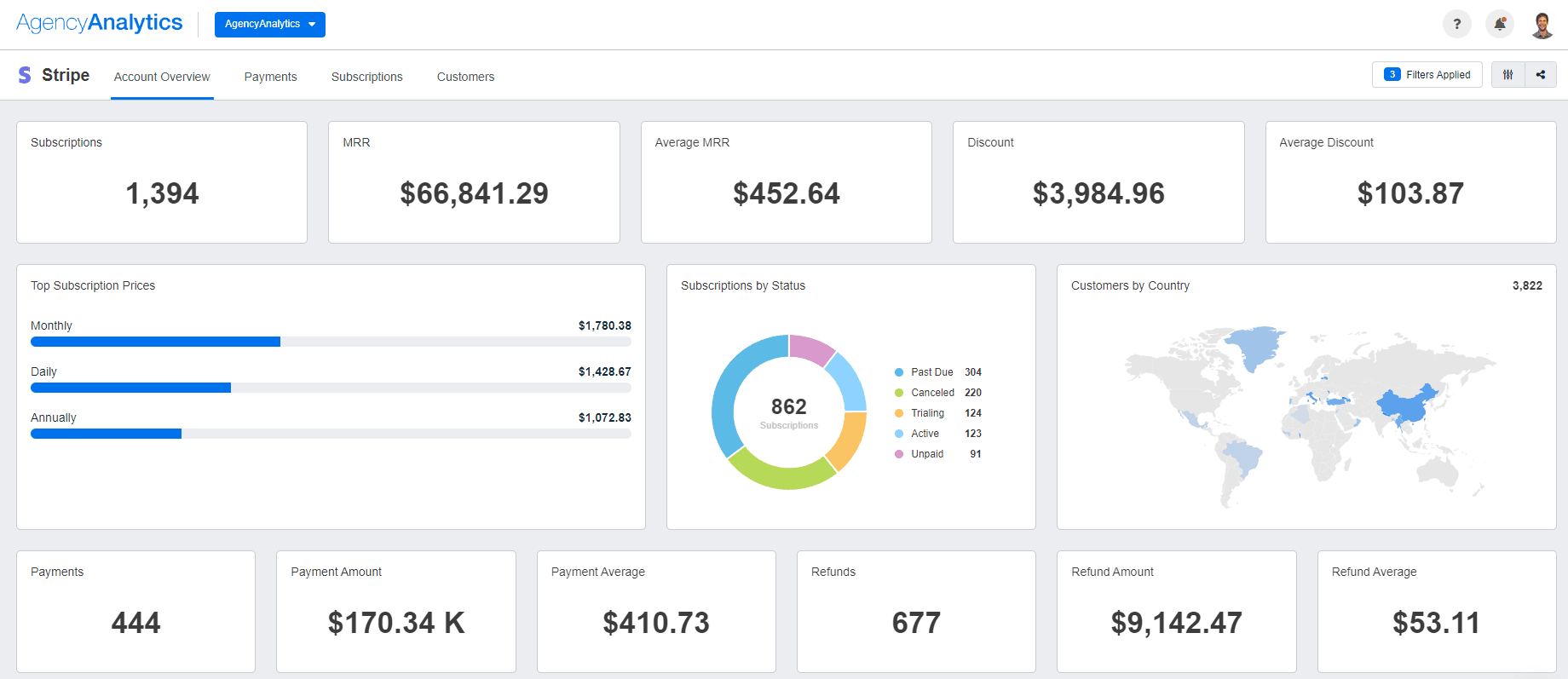
Keep track of customer acquisition and retention metrics using the Stripe reporting integration and a professional Stripe dashboard template.
8. Brand Sentiment
All companies want to be perceived well in their markets. Brand sentiment measures how your clients’ customers view their brand. Ensuring positive brand sentiment is a key goal for many clients.
Tips for Success
Create engaging content centered on your client’s audience.
Focus your marketing efforts on highlighting sustainability efforts.
Build an active social media presence and engage with your client’s audience.
Measuring Brand Sentiment Rates
When tracking customer sentiment rates, you’ll want to watch Net Promoter Scores (which shows how likely customers are to recommend your client to others), as well as customer satisfaction scores and customer feedback surveys.

Monitor customer sentiment by creating easy-to-understand ratings, reviews, and customer satisfaction reports.
9. Cost Reduction
Depending on where your client’s company is in the scaling process, cost reduction could be an important goal to ensure long-term sustainability.
Tips for Success
In order to optimize all marketing campaigns, conduct a marketing audit. This will help you pinpoint any inefficiencies and reallocate the marketing budget to maximize ROI.
Guide your client through vendor contract negotiations.
Implement automated technical solutions to reduce labor costs and streamline processes. For example, AgencyAnalytics’ automated reporting features quickly create customized reports for your clients, eliminating time and labor costs.
Measuring Cost Reduction
To properly measure cost reduction, track ROI rates, costs per acquisition rates, and customer acquisition costs.
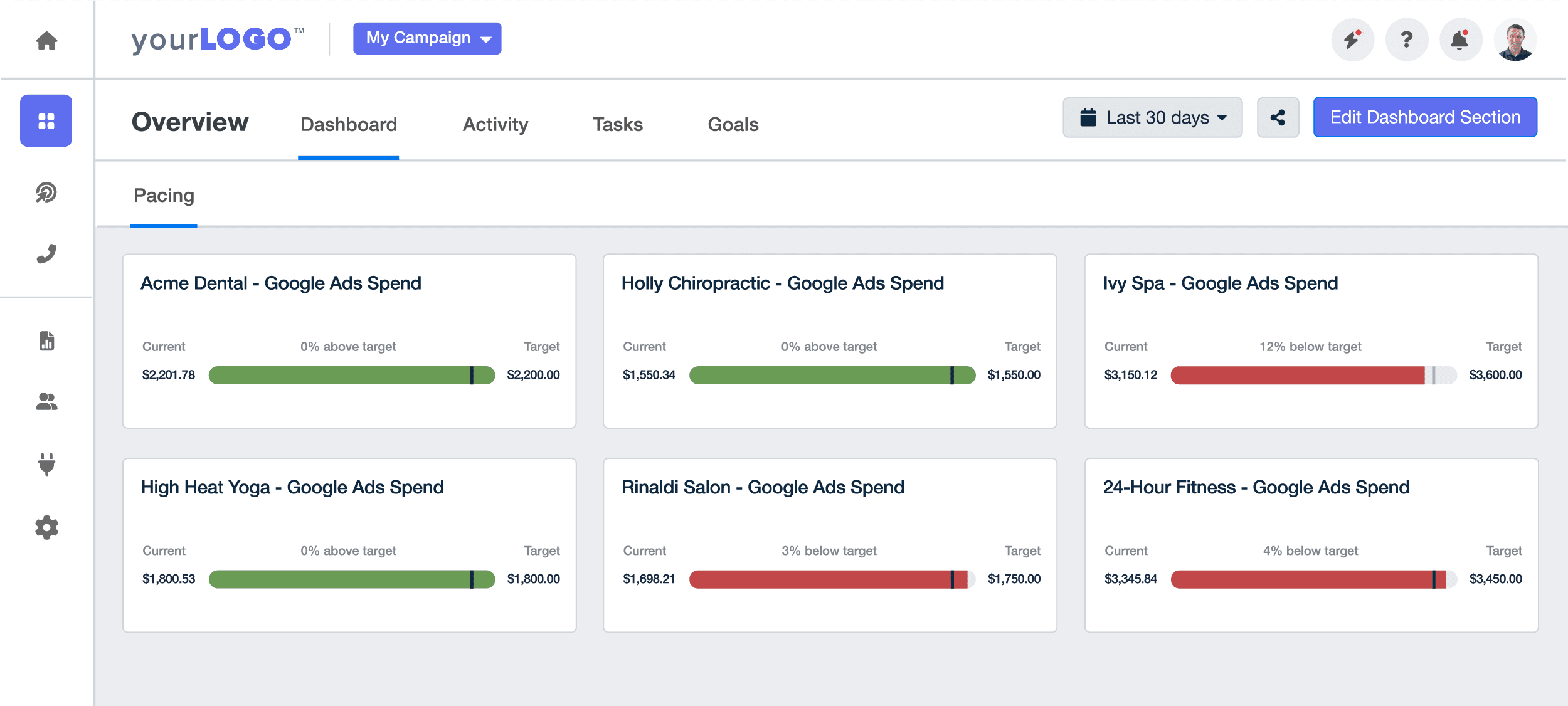
Create a budget-pacing report to keep your fingers on the pulse of all your client's ad spend.
10. Increasing Revenue
This one shouldn’t be a surprise to any marketer. Revenue is a key motivator for businesses, making it top of mind for clients. When examining top marketing goals, HubSpot found that increasing revenue was number one at 27%.
Tips for Success
To increase revenue through top of the funnel marketing objectives, it’s important to create a solid online presence, both through social media campaigns and web content.
For those focused on the middle of the funnel, increase revenue by finding qualified leads through automated lead nurturing emails and marketing campaigns targeted at your client’s customers’ immediate pain points.
Bottom of the funnel tips include sharing product demos, case studies, and tutorials to promote your clients’ authority.
Measuring Revenue
It’s important to track average revenue per user, annual recurring revenue, quota attainment, and your client’s win rate.
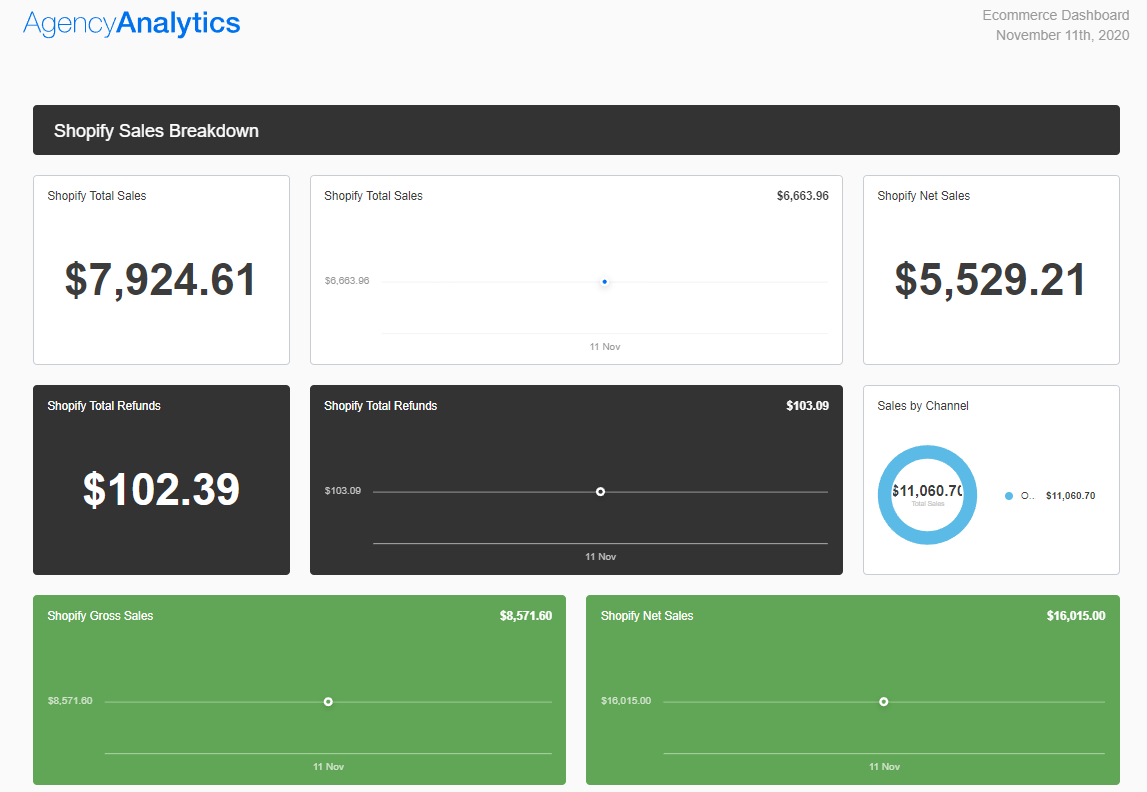
Use a customizable eCommerce dashboard to automatically gather and visualize your clients top Ecommerce and revenue KPIs.
Every client has unique challenges and goals, so it's crucial to take the time to tailor your reports to their specific needs. By doing so, you'll be able to provide valuable insights that speak directly to their business objectives, and ultimately help build stronger relationships with your clients.
Adam Binder, Founder + CEO, Creative Click Media
Step 3: Track Progress Through Data and Analytics
Client reporting is an essential part of goal management. If the client doesn’t have a clear idea of where they stand and how well they’re progressing towards their marketing objectives, it’s difficult to create a transparent dialogue about their campaigns.
In many ways, we’re preaching to the choir. Marketing agencies understand the importance of sharing campaign results. But let’s face it: relaying analytics is sometimes a complicated endeavor. Between deciding which metrics to share and compiling data from a variety of sources, you’re often left spending a significant amount of time and effort trying to communicate results with clients.
We don't just hand over reports; we put a spotlight on the key performance indicators (KPIs) that matter most to our clients, showcased prominently with their goals in mind.
Michelle Van Blerck, Communications Manager, Digital Freak
Goal-Based Reporting for the Win
Goal-based reporting allows agencies to successfully communicate analytical highlights that matter most to each client’s goals. These reports turn complicated data into easy-to-read spotlights featuring relevant achievements that your clients will actually care about. This type of communication helps validate your agency’s abilities and reassures clients about your agency’s ROI potential.
With AgencyAnalytics’ Annotations and Goals feature, marketing agencies quickly create personalized reports about trackable goals using client data. Easily track client goals using a progress bar in your marketing dashboards, saving time and increasing efficiency.

Setting Goals, Achieving Success
Managing client goals is an essential part of successful agency operations. By building trust and aligning with your clients, you help them effectively set realistic, trackable goals that support long-term growth.
We have a diverse roster of clients with different marketing goals and KPIs that they prioritize. Customizable dashboards and report templates allow our team to deliver the metrics and data that our clients care about and that give them the best understanding of the success of their campaigns while ensuring all data is still at their fingertips.
Paul Echols, Creative Director and Agency Owner, Square 205
Once these digital marketing goals are set using a goal setting framework, monitoring analytics is crucial in order to properly understand your progress towards reaching each touchpoint.
Whether you’re tracking lead gen, customer retention, brand engagement, or industry authority, AgencyAnalytics’ reporting dashboards allow marketing agencies to effectively track and share key data points with clients.
Create automated reports featuring data from more than 80 marketing platform integrations, our solution empowers agencies to effortlessly share impactful insights. Try it out for yourself with a free 14-day free trial.
FAQs About Marketing Goals for Clients
Still have questions about marketing goals for clients? Don’t worry—we’ve got you covered.
Client goals are specific outcomes that a marketing strategy aims to achieve on behalf of a client, such as increasing website traffic, generating qualified leads, improving brand awareness, or boosting customer retention. These goals must be clear, measurable, and tied directly to the client's broader business objectives.
Agencies track progress by setting clear KPIs at the start, then using platforms like AgencyAnalytics to centralize and monitor real-time data. Custom dashboards, automated reporting, and goal-specific widgets help agencies visualize performance trends and identify where to focus efforts to stay aligned with client targets.
Agencies should avoid setting vague or unrealistic goals, ignoring baseline data, or focusing only on vanity metrics. Goals must be specific, data-driven, and achievable. Setting clear expectations with clients upfront and ensuring alignment between marketing activities and actual business outcomes is essential to avoid disappointment.
Agencies should analyze campaign data to identify underperforming areas, then pivot strategies based on those insights. This might include reallocating budget, refining audience targeting, updating messaging, or testing new channels. Transparent communication with clients about what’s changing and why helps maintain trust and momentum toward the ultimate goal.

Written by
Rita Poliakov is an experienced content writer with a knack for storytelling. As a former journalist, she's a skilled researcher, interviewer, and grammar nerd.
Read more posts by Rita PoliakovSee how 7,000+ marketing agencies help clients win
Free 14-day trial. No credit card required.




